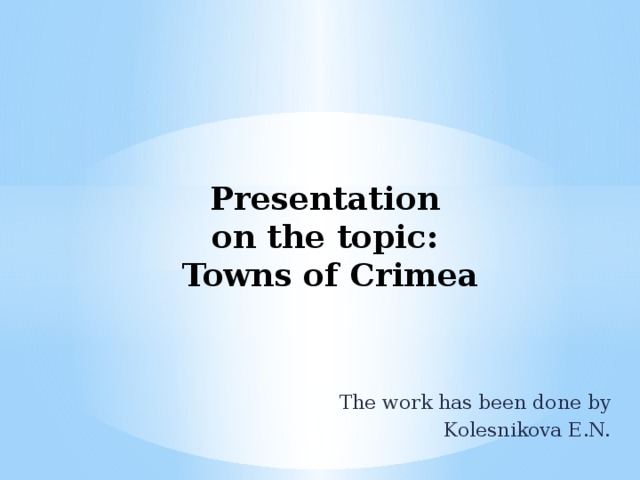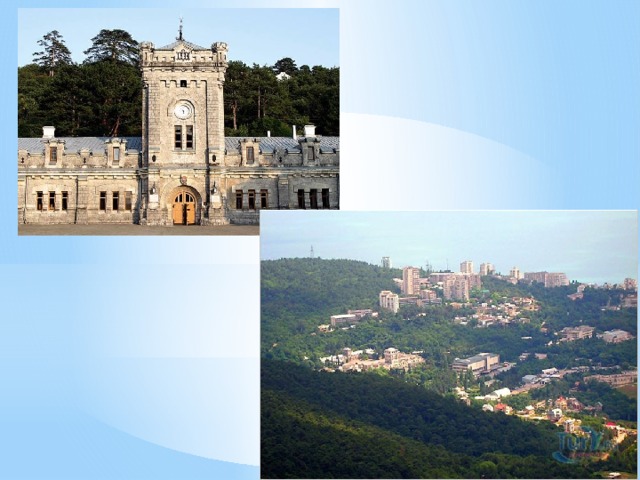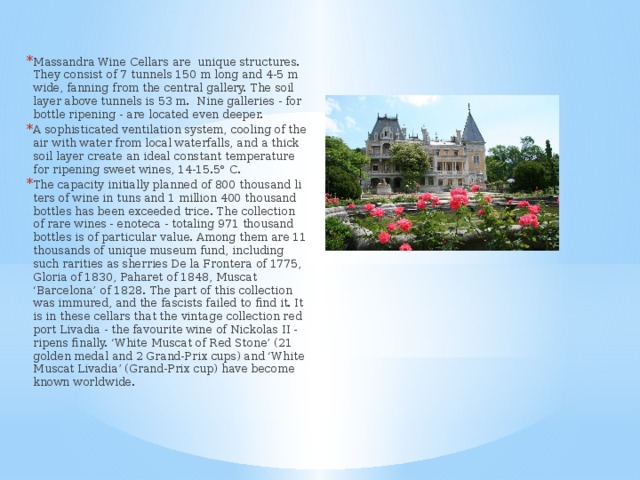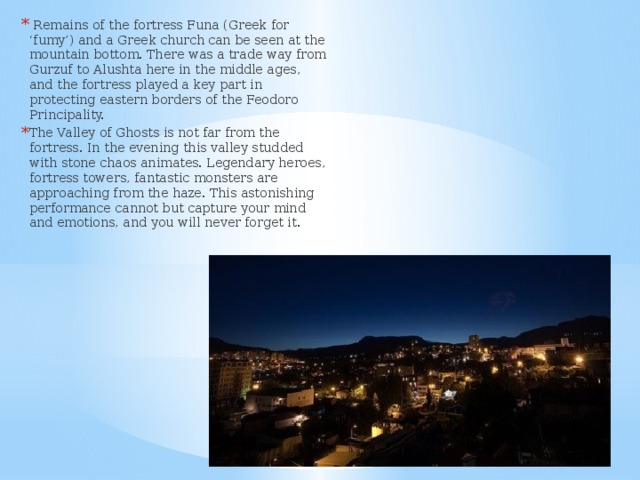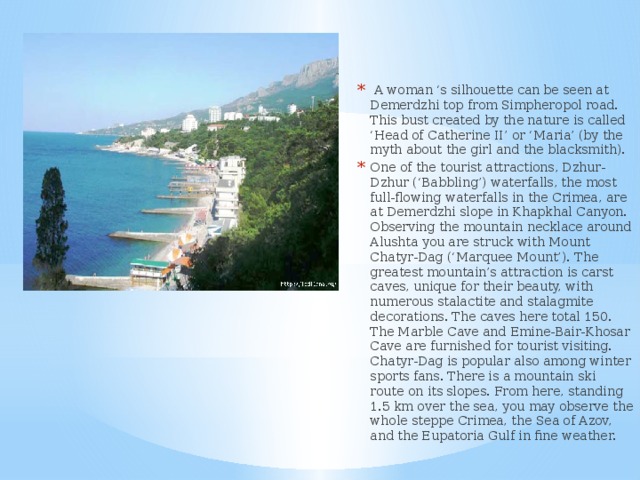Greater Yalta
Greater Yalta stretches for 72 km from Gurzuf to Phoros and includes Simeiz, Alupka, Miskhor, Koreiz, Gaspra, Livadia, Oreanda, and Massandra. This is a unique landscape park and historical cultural area with excellent mild healing climate.
The word ‘Yalta’ translated from Ancient Greek means ‘coast’. It was this marvelous coast that Greek sailors saw after a terrible storm and where they founded the settlement of Yalita. The Tauri lived in the neighbourhood. Their burial places dating back to 6th-5th cc. BC were found on the slopes of Polikurovskiy Hill. The remains of Iskhar Fortification and a temple in the Iograph Cave have been preserved since the Middle Ages. For the first time the town was mentioned in the 12th c. as Yalita. Since the 14th c. it has been marked on sea geographical charts of Europe under various names.
The rapid development of the town started after the governor of the Novorossiysk region the Count Vorontsov in 1824-1848 laid down a road from Yalta to Simpheropol, and later to Sevastopol.
At the same time the Cathedral of St. John Chrysostom was built. The tall bell-tower became a reference for sailors. With the Romanovs having bought an estate in Livadia, Yalta transformed into a prestigious aristocratic resort.
Yalta itself is located in the center of a huge mountain amphitheater. Alps reach 1,300-1,500 m above the sea level. Two mountain rivers flow through the town - the Derekoika (the Rapid) and the Uchan- Su. The latter is known for the highest Crimea’s waterfalls - the Uchan-Su (Flying Water) located 8 km from Yalta, on the road to Ai-Petri in the marvelous pine forest. The water is rushing down from a sheer steep 98.5 m high. The waterfalls are particularly impressive in spring in snow melting or after heavy rains.
The famous Yalta’s embankment, a favourite promenade place for holiday-makers, stretches between the Uchan-Su and the Derekoika estuaries. The splendid Primorsky Park starts from the hotel ‘Oreanda’. The picturesque Massandra Park was planted by M. Vorontsov on the other side of Yalta in the 19th c.
Among Yalta’s sightseeing tops the Palace of Bukhara Emir (1903) is worth mentioning. At the splendid embankment the eye is caught by the huge
500 -year-old sycamore of Isadora Duncan. Here the famous ballet dancer was dating poet Sergei Yesenin. The hotel ‘Mariino’ (1883, 1898, 1903, by N. P. Krasnov and N. Tarasov) hosted many outstanding figures of Ukraine and Russia. In 1899 Anton Chekhov checked in here next to Olga Knieper, and he came up with an idea of the famous story ‘Lady with Lapdog’. From here he moved to a house on the plot bought by him in the village of Verkhniaya Autka (at present it is Yalta’s district Chekhovo). Writer’s house museum was created there. In Yalta A. Chekhov wrote world-wide known plays ‘Three Sisters’ and ‘The Cherry Orchard’. The Church of St. Fyodor (Theodore) Tyron where Anton Chekhov married the actress Olga Knipper is located close to Chekhov’s house.
The name of Lesia Ukrainka is also associated with Yalta. Here she wrote ‘Iphigenia in Taurida’ and a series of poems. The museum was opened in the house where she stayed in 1907-1908. In addition to the display dedicated to the Ukrainian poetess one can find a lot of unique things of her Yalta’s life there.
The architectural and design solution distinguishes the Church of St. Hripsime (architect G. Ter-Mikaelian). The 100-Step staircase leads to the church. It is decorated with original paintings and ornaments performend by the Armenian painter V. Sureniants buried at The temple’s wall.
No one cannot but be impressed by the Cathedral of St. Alexander Nevsky (archt. K. Platon) erected under the direction of the famous Yalta architect N. Krasnov in 1902. The cathedral was built in memory of the tragic death of Alexander II.
The row of the most fashionable health centers and rest houses buried in verdure of marvelous parks starts westward from Yalta. The first one is ‘Low Oreanda’ (Greek for ‘Rocky’), the former estate of Alexandra Fedorovna, the wife of the Emperor Nicholas I. A park of unique beauty, a rotunda, and Intercession Church with fragments of splendid mosaics by Italian master A. Salviatti have been preserved from the gorgeous tsar’s palace. Poets P. Viazemsky and I. Annensky dedicated their poems to Oreanda, here A. Chekhov placed the heroes of his ‘Lady with Lapdog’.
The peak of steep Rock Aurora is harmoniously topped with the Crimea’s symbol - the Swallow Nest Castle. Nearby, at Cape Ai-Todor, the most famous Crimean lighthouse, a sailors’ identification point, is located. Here, in Ai-Todor Valley, at Swallow Nest bottom, the Golden Fleece was kept in the mythical cave, and in the 70 AD, under the Roman Emperor Vespasian, the cape was topped with the fortress Kharaks.
In 1907, the architect N. Krasnov erected one of his astonishing palaces and the delicate church of Our God Transfiguration and St. Nina just near the fortress, in the estate of the Grand Prince Georgiy Mikhailovich. The church was built in commemoration of miraculous healing of grand prince’s daughter Nina.The Kharaks Palace is designed in Scottish style and roofed with ‘English tile’. Each facade is both peculiar the architect’s creative method and inimitable can get the complete idea of the palace only und it. The palace is surrounded with the Kharaks Park-Museum with unique grovesof 300-500-year old pubescent oaks and 500-1000 year old Greek junipers.Everybody's eye in the park is caught by an Athenian pavilion with a fountain in the middle, built in ancient Greece. At the beginning of the 20th c. the Grand Prince Georgiy Mikhailovich brought it from Greece for his beloved wife Grand Princess Maria Georgiyevna so that the princess born in Greece could feel in the Crimea like at home.
Another remarkable creature by N. Krasnov is the palace ensemble of the Grand Prince Petr Nikolayevich - Diulber - built in Miskhor in 1895-1897. It looks unusual due to Saracen style of 10th-13 th cc. Egypt and Syria. The snow-white palace is hidden by palm verdure and appears in all its beauty when you are strolling around. It amazingly changes at each turn. It is as if you were in Sheherezada's tale. The image becomes even more evident thanks to a mountainous relief and a luxurious park with fountains.
The palace of princes Yusupovy is nearby, in Koreiz. Here was the residence of Soviet delegation headed by I. Stalin during the Crimean 1945 Conference.
The Greater Yalta coast is marvelous, the area between Simeiz (Greek for ‘sign’) and Phoros just strikes imagination with its beauty. Mounts Cat, Dragon, Paneya, Rocks Diva, Swan's Wing, Biyuk-Isar, ‘Stone Sea' near the village of Opolznevoye, combined into fantasy, form miraculous landscapes you cannot but admiring again and again. Since the late 19th c. the most prestigious dachas (‘summer villas’) including the famous residence of M. Gorbachov in Phoros have been located here. At present Gorbachov’s dacha has been transformed into the residence of the President of Ukraine. Resurrection Church is above it at the height of 400 m on the top of Red Rock, as if flying in the clouds. The church was built by the architect N. Chagin in 1892 to commemorate the lucky rescue of the Emperor Alexander III during the derailment at the station of Borki. Painting was performed by artists K, Makovsky and A. Korzukhin.
The Baidarsky Pass is over the church. In 1848 the Baidarsky Gate was constructed here in honour of completion the Sevastopol-Yalta road.
Greater Yalta is not just these fairy-tale places. There are two more where human creatures and original nature make together a particular impression - Alupka and Livadia.
